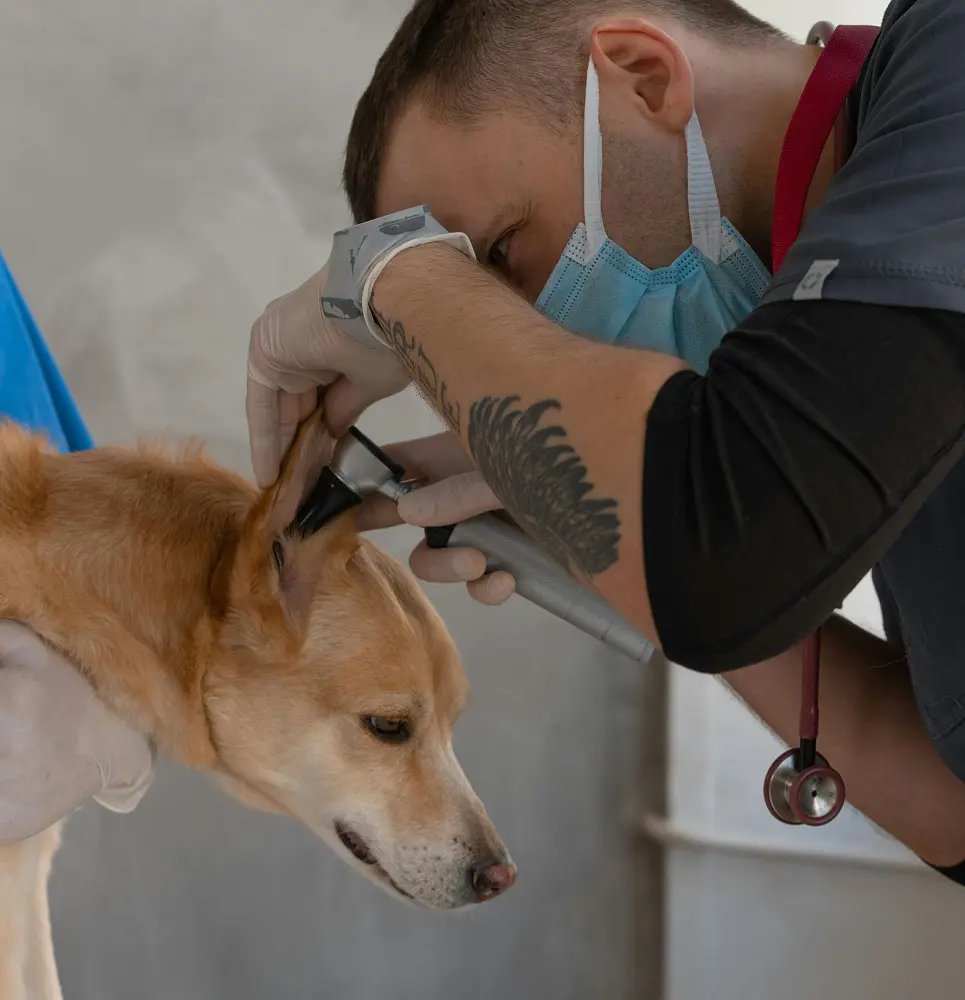18 Causes Of Ear Mites In Dogs And How To Care For Them

It's expected of people to think that dogs' excessive head shaking and ear scratching are normal behaviors. These behaviors, meanwhile, may indicate more serious problems, like an infestation of ear mites.
The affected dogs are extremely irritated and uncomfortable by their presence. Dogs can contract ear mites easily and quickly through shared environments or direct touch. Some common symptoms are excessive scratching, head shaking, black ear discharge, and an unpleasant smell.
1. Direct Contact
The main way that ear mites, a common parasite infestation in dogs, spread is by direct contact with an afflicted animal. These minuscule parasites grow within the ear canal, where they eradicate skin fragments and ear wax.
Dogs who play, groom, or share beds with other animals may come into close contact with other animals and pick up ear mites. This is one of the most common reasons for ear mites on dogs.
Due to their high contagiousness, ear mites can spread quickly among families with multiple pets, kennels, and shelters. As such, living near infected dogs raises your chances of contracting this painful illness considerably.
2. Environment
The environment also has a significant impact on the growth of these parasites. Ear mites may last brief periods without a host, especially in warm, humid environments.
These parasites can live in common living areas, grooming supplies, bedding, and toys that have been contaminated. Also, ear mites can be found in outdoor settings like dog parks or places where other animals gather.
Ensuring that a dog's environment is thoroughly cleaned and disinfected is crucial to stopping the transmission of ear mites within a home or neighborhood and preventing reinfection.
3. Lack of Hygiene

Inadequate personal hygiene practices may contribute to dog ear mite infestations. A dog's surroundings may be poorly cleaned, which can lead to the survival and spread of mites.
These parasites have the ideal breeding environment in the ear canal due to accumulated debris, ear wax, and moisture. Also, neglected toys, grooming supplies, and shared beds can all contain mites.
Maintaining ear mite infestations and avoiding subsequent illnesses require consistent ear cleaning and good personal hygiene. To properly eradicate ear mites, veterinary-approved medicines must target the underlying parasite problem.
4. Weakened Immune System
An immune system that is weakened can make a dog much more vulnerable to ear mite infestations. The body's natural defenses against these parasitic invaders are hampered by a weaker immune system, even if direct contact with infected animals is still the major means of transmission.
An immune system that is compromised can be caused by many factors, such as advanced age, underlying medical disorders, starvation, and exposure to environmental stresses. Dogs who are older or puppies frequently have weakened immune systems, which makes them more susceptible to ear mite infections.
Dogs who suffer from long-term conditions like diabetes or autoimmune diseases may also have weakened immune systems, which raises their risk. A strong immune system depends on proper nutrition, and malnutrition can weaken the body's defenses against parasites.
5. Puppies and Young Dogs
Dog ear mites are mostly spread by direct contact with animals that are affected. Puppies and young dogs are more vulnerable to infection because of their underdeveloped immune systems, which makes them more prone to parasitic infestation.
The ear canal is home to the mites, which are frequently minuscule and resemble tiny spiders. They feed on cellular detritus and cause excruciating pain. Their fast reproduction cycle makes the infestation worse, causing pain, swelling, and secondary yeast or bacterial infections.
These ectoparasites transmit more easily when puppies are in close quarters with diseased canines, share beds, or come into contact with contaminated settings, which we have already explained above.
6. Neglected Ear Care

One of the main causes of dog ear mite infestations is neglectful ear care. Ear mite proliferation thrives in a wet, dark environment that is produced by inadequate cleaning and drying of the ear canal.
The buildup of wax, dirt, and moisture weakens the ear's natural defenses, making parasite invasion more likely. In addition, the lack of routine ear exams makes it difficult to identify infestations early on, which permits mite populations to grow unchecked.
As a result, a continuous disregard for canine ear cleanliness greatly raises the possibility of ear mite development, as well as the discomfort and health problems that follow from these parasites.
7. Outdoor Exposure
Dog ear mite infection is largely influenced by outside exposure. Warm, humid conditions and close animal contact are ideal for the growth of these microscopic parasites. Dogs who go to parks, dog parks, or other public areas more often are more likely to get ear mites.
These parasites are spread through direct contact with diseased animals, such as stray dogs or dogs owned by other people. Furthermore, ear mites can live on a variety of external surfaces, such as dirt, plants, and even tainted water sources.
As a result, dogs investigating these areas could unintentionally come into contact with ear mites, which could result in an infestation. Dogs who are outside have a higher chance of developing an ear mite infection. Therefore, regular prevention measures and meticulous ear cleaning are crucial.
8. Contact with Wild Animals
Canine ear mites are a common parasite infestation that can be caught in many ways. Direct contact with wild animals is one significant means of transmission. These animals can act as reservoirs for the parasites since they frequently carry ear mites.
The danger of mite transfer is increased when domestic dogs come into contact with infected wildlife, whether through shared surroundings, territorial clashes, or chance encounters.
These minuscule organisms can easily settle in a dog's ear canal due to their capacity to adapt to various environments. This causes irritation, inflammation, and eventually discomfort for the canine.
9. Close Quarters

Dogs' ear canals are home to small parasites called ear mites, which are extremely contagious and enjoy conditions where animals are close to one another.
Multi-pet households, kennels, and shelters offer the perfect environment for these pests to spread quickly. In these environments, animals are in close physical touch with one another, which makes it easier for ear mites to spread directly and quickly through infestation.
Shared toys, bedding, and grooming supplies can also act as routes for the parasites' propagation. As a result, dogs living in close quarters have a higher chance of ear mites, which highlights the significance of routine veterinary exams and prophylactic care in these settings.
10. Seasonal Changes
Seasonal fluctuations could affect the prevalence of dog ear mite infestations. Seasonal variations in temperature and humidity can foster an environment that is conducive to mite growth.
Canines may also be more likely to become infected if they engage in outdoor activities during particular seasons and come into touch with wildlife or other canines. These elements may make dogs more vulnerable to ear mite infestations, along with compromised immune systems or underlying ear conditions.
While seasonal influences do exist, it is important to remember that preventative measures and routine ear care are still critical for preserving canine ear health all year round.
11. Breed Predisposition
Although dogs of any breed can become infected with ear mites, some breeds are more susceptible than others. A dog's risk of having ear mites can be influenced by various factors, including coat type, ear structure, and general allergy susceptibility.
For example, dogs with floppy ears are more likely to get ear infections because of the warm, damp environment that encourages the growth of microorganisms.
Also, because these factors can provide an ideal home for ear mite infestations, breeds with thick or oily coats may be more vulnerable to these infestations.
12. Infected Mother

The upward spread of ear mite infestation from an infected mother to her offspring is one of the main routes of infection in dogs. Puppyhood makes them especially vulnerable because of their immature immune systems.
Ear mites are spread more easily when a mother's kids come into close touch with her while feeding or grooming. Otodectes cynotis, the minute parasites, proliferate quickly in the warm, enclosed environment of the ear canal.
In a litter, this maternal transmission frequently leads to a high incidence of ear mites, underscoring the significance of early detection and prophylactic measures in limiting the spread of this infectious parasite.
13. Lack of Veterinary Care
One major factor in the occurrence of canine ear mites is the lack of routine veterinary care. Regular exams allow for the early discovery of parasite infestations, such as ear mites, which in turn allows for timely treatment and stops the infestation from spreading.
Further, vets offer crucial advice on how to prevent parasites, maintain proper ear cleanliness, and stress the value of routinely cleaning and checking a dog's ears.
Dogs who receive neglected veterinary care are more likely to develop ear mite infections because they do not receive professional diagnosis, treatment, or preventive care. This carelessness may cause the animal to suffer for an extended time and may result in problems from untreated ear issues.
14. Allergies
The tiny parasites known as ear mites live only in the ear canal and feed on ear wax and oils. When they are around, dogs usually experience severe itching, trembling in the head, and a waxy, dark discharge.
Conversely, allergies can irritate and inflame the ears, which frequently results in subsequent yeast or bacterial infections. Since these symptoms can resemble those of ear mites, a precise diagnosis is essential.
A veterinarian's advice is crucial to identify the underlying cause of ear issues and start the proper therapy, be it for ear mites, allergies, or a combination of the two.
15. Secondary Infections

Canine ear pain is often caused by microscopic parasites ear mites, which live in the ear canal. Even though these mites themselves might cause discomfort and inflammation, their existence frequently opens the door to more serious issues.
An ear mite infestation can cause behaviors like constant scratching and head shaking that can physically harm the ear canal. Also, the inflammation that the mites cause creates a warm, wet environment that is perfect for the growth of bacteria and yeast.
These opportunistic microbes can quickly cause secondary infections, which would make the dog even more uncomfortable and require more intensive care. Thus, it's critical to treat ear mite infestations as soon as possible to stop the emergence of these potentially excruciating and chronic secondary diseases.
16. Skin Conditions
Underlying skin problems can make the problem worse and provide an environment that is favorable for the mites to proliferate. A common skin condition called allergic dermatitis frequently presents as severe itching that causes repeated scratching and rubbing of the ears.
The ear canal's delicate balance may be upset by this ongoing discomfort, which increases the area's vulnerability to ear mite infestation. Also, seborrhea, a disorder marked by oily skin and dandruff, might offer ear mites a nutrient-rich habitat in which to grow.
Further, the ear's natural defenses may be compromised by bacterial or yeast infections that result from skin disorders, which raises the likelihood of infestation even further. Therefore, treating underlying skin issues is essential to both avoiding and curing dog ear mite infections.
17. Stress
While stress is not the main cause of ear mite infestations, but it can worsen pre-existing ear disorders and weaken a dog's immune system. These tiny parasites ear mites live in the ear canal and feed on ear wax and dirt.
They are mainly spread by direct contact with animals that are diseased or through common habitats.
So, for effective treatment and prevention, it is crucial to identify and manage the underlying parasite condition, even if stress may indirectly increase a dog's vulnerability to ear mite infestations by reducing their immune response.
18. Genetics

Certain breeds may be predisposed to ear mite infestations through genetics, either directly or indirectly. Specific breeds frequently have structural characteristics, like as long, floppy ears or ear canals with distinctive architecture, that produce an environment suitable for ear mite multiplication.
These breeds may be more prone to ear infections, which weaken the ear's natural defenses and increase the risk of a mite infestation. Furthermore, underlying genetic predispositions to allergies or immune system deficits might jeopardize ear health, making these dogs more susceptible to ear mite infestations.
Hence, it is important to emphasize that heredity is only one contributing element because ear mites are usually spread through direct contact with sick animals, which we have been mentioning time and again.
How To Care Dog's Ear Mites
Veterinary-prescribed topical medicines are usually used to treat dog ear mites. When used as instructed, these medications, such as ear drops, lotions, or ointments, effectively eradicate the mites. Recurring skin infections brought on by frequent scratching can need further medical intervention.
Regular ear cleaning with a wet cloth is advised to identify mites early and prevent infestations.
Certain topical medications also have anti-flea and anti-ear mite qualities. Regular use of these treatments along with thorough ear hygiene can greatly lower the incidence of ear mite infections.
Recent posts
Dogs
Why Is My Dog Panting? 18 Reasons For Breathing Fast
Dog owners, those in tune with their pets, can often notice a change in their companion’s behavior. When unwell or scared, some dogs hide while others seek solitude. Similarly, panting is a normal sign of tiredness or lethargy, but can also imp...
10 Reasons Behind Dogs Chewing And Licking Their Paws
Some of the most harmless behaviors dogs depict are chewing on their paws. But if this obsession catches onto your pup, well, that raises a couple of curious eyebrows. Your dog's tendency towards chewing and licking can affect general health and well...
18 Reasons Why Your Dog Is Not Eating
A skipped meal here or there is normal, but your dog consistently refusing food is the cause of concern. The reasons range from dietary issues to more serious health conditions and behavioral issues. The dog may be a picky eater or there might be som...
17 Causes Of Seizures In Dogs
Don't dismiss your pet dog's uncontrolled twitching movements as harmless shivering - you may be bearing witness to the classic signs of a seizure. These sudden and involuntary electrical disturbances can drastically impact a dog's health and even ch...
18 Reasons Why Your Dog Is Drooling So Much
While drooling in dogs is perfectly normal in certain situations, excessive or continued drooling may hint at a more serious issue that requires attention. Once you know the probable causes of this drooling in your dog, you can take some necessary st...
18 Reasons On Why Is My Dog Limping
A dog limping can be a cause of concern and cause stress to owners. It is not normal dog behavior and can be a sign of health problems in dogs. Understanding why your dog is limping is important to cure this problem. This article discusses 18 reasons...






